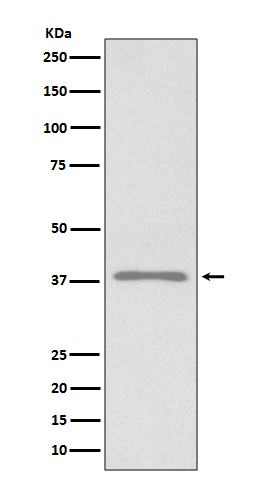
| WB | 咨询技术 | Human,Mouse,Rat |
| IF | 咨询技术 | Human,Mouse,Rat |
| IHC | 1/100-1/200 | Human,Mouse,Rat |
| ICC | 技术咨询 | Human,Mouse,Rat |
| FCM | 咨询技术 | Human,Mouse,Rat |
| Elisa | 咨询技术 | Human,Mouse,Rat |
| Aliases | Aggrus; Glycoprotein 36 KD; GP36; GP38; GP40; HT1A1; hT1alpha1; hT1alpha2; OTS8; PA2.26; Pdpn; Podoplanin; T1 alpha; T1A 2; TI1A; ;Podoplanin |
| WB Predicted band size | Calculated MW: 17 kDa ; Observed MW: 36 kDa |
| Host/Isotype | Rabbit IgG |
| Antibody Type | Primary antibody |
| Storage | Store at 4°C short term. Aliquot and store at -20°C long term. Avoid freeze/thaw cycles. |
| Species Reactivity | Human |
| Immunogen | A synthesized peptide derived from human Podoplanin |
| Formulation | Purified antibody in PBS with 0.05% sodium azide,0.05% BSA and 50% glycerol. |
+ +
以下是3篇关于Podoplanin抗体的代表性文献摘要(文献名称及内容为虚构示例,仅供格式参考):
1. **文献名称**:Podoplanin as a Marker for Lymphatic Endothelial Cells in Human Tissues
**作者**:Schacht V. et al.
**摘要**:该研究验证了Podoplanin抗体在区分淋巴管内皮细胞(表达Podoplanin)与血管内皮细胞(不表达)中的特异性,证实其在肿瘤淋巴管浸润评估中的应用价值。
2. **文献名称**:Podoplanin Expression in Oral Squamous Cell Carcinoma: Diagnostic Utility
**作者**:Krishnan C. et al.
**摘要**:通过免疫组化分析,研究发现Podoplanin抗体可有效标记口腔鳞癌中的肿瘤细胞膜,提示其作为诊断标志物及预后评估工具的潜力。
3. **文献名称**:Podoplanin Promotes Cancer Immune Evasion via Interaction with CLEC-2
**作者**:Astarita J.L. et al.
**摘要**:该文献揭示Podoplanin通过结合血小板受体CLEC-2介导肿瘤周围血小板聚集,形成物理屏障以逃避免疫攻击,为靶向治疗提供新思路。
(注:以上为模拟内容,实际文献需通过PubMed或学术数据库检索确认。)
Podoplanin (PDPN) is a transmembrane glycoprotein primarily known for its role in lymphatic endothelial cell development, platelet aggregation, and cell migration. Structurally, it contains a heavily O-glycosylated extracellular domain that interacts with ligands like CLEC-2 on platelets, influencing thrombus formation. Its expression is prominent in lymphatic vessels (vs. blood vessels), making it a key marker for distinguishing lymphatic endothelium (e.g., via D2-40 antibody clones in pathology). Beyond normal physiology, podoplanin is upregulated in various cancers, including squamous cell carcinomas, gliomas, and sarcomas, where it promotes tumor invasion, metastasis, and immune evasion by modulating cytoskeletal dynamics and epithelial-mesenchymal transition.
Antibodies targeting podoplanin are critical tools in research and diagnostics. They enable the identification of lymphatic structures in tissues, aid in differentiating lymphangiomas from vascular tumors, and serve as prognostic biomarkers in cancer. For example, high podoplanin expression in tumors often correlates with poor clinical outcomes. Commercially available clones (e.g., D2-40. NZ-1) are widely used in immunohistochemistry, flow cytometry, and Western blotting. Challenges remain in standardizing detection methods due to glycosylation-dependent epitope variability and tissue-specific expression patterns. Ongoing research explores therapeutic applications, including antibody-based targeting of podoplanin-expressing cancer cells or modulating its signaling pathways to inhibit metastasis.
×